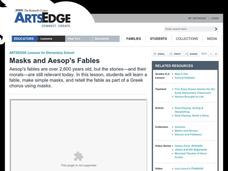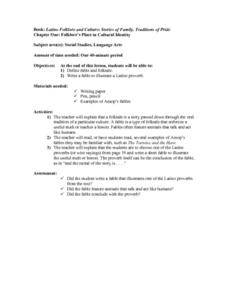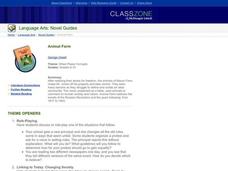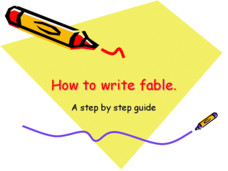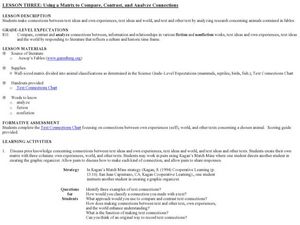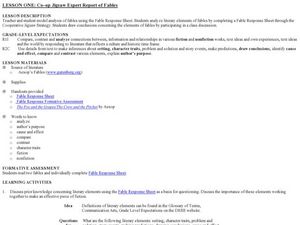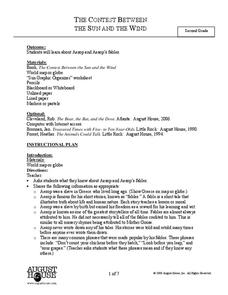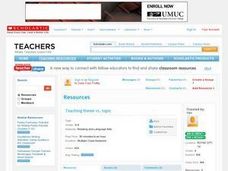Curated OER
All About Aesop
First graders explore the genre of fables. In this fables lesson, 1st graders use various reading strategies to raise comprehension skills. Students make prediction and complete a prediction journal. Students understand that fables have...
Curated OER
Masks and Aesop's Fables
Students study and perform Aesop's fables. In this Aesop's fables instructional activity, students read and/or listen to a number of the famous fables. They make masks based on the characters and perform a fable using the masks. They...
Curated OER
Counting Crows
Students discuss the fable, The Crow and the Pitcher. In this literature lesson, students read the fable and create a crow sock puppet. Students use their puppets to dramatize the fable.
Curated OER
Animal Tales Around the World
Learners explore characteristics of Indian Tales/ Parables. In this literature lesson, students compare contemporary society to western culture through analysis. Learners create their own tales using this genre.
Curated OER
Aesop's Fables: Unity
In this language arts and literature worksheet, students read 3 separate Aesop's fables that all have the theme of unity. Students then complete 5 pages of essay questions, short answer, detail checking, higher meaning reflections and...
Curated OER
Aesop's Fables: Fitting In
In this literature worksheet, students read one of Aesop's fables that has the theme of fitting in. Students then complete 7 pages of questions: detail checks, deeper meanings, imagination exercises, drawing characters and scenes, a...
Curated OER
Latino Folklore and Culture: Stories of Family, Traditions of Pride
Students define the terms fable and folktale. They write a fable to illustrate a Latino proverb. Students are explained that a folktale is a story passed down through the oral tradition of a particular culture. A fable is a type of...
Curated OER
The Empty Pot: A Lesson About Integrity
Learners discuss whether honesty really is the best policy with a lesson on "The Empty Pot," a Chinese fable about integrity. After reading the story, class members answer several comprehension and reflection questions about what they...
Curated OER
Fables
Third graders identify the characteristics of fables, and read and compare/contrast various Aesop's fables. Using handheld computers, they read two fables with a partner, complete a Venn Diagram, develop a traits diagram using PiCo Map,...
Curated OER
Fables
Third graders discover characteristics of fables by reading Aesop's fables and performing a reader's theater.
Curated OER
Animal Farm
Students read Animal Farm and examine how power corrupts. They role-play situations involving power and control. They investigate corruption and abuse of power in society. They write propaganda articles and hold panel discusssionsabout...
Curated OER
Folktales
A brief list of folktales is displayed on these slides. Four types are written out with an example for each fairytale, tall tale, fable, and trickster tale. The last slides segues into the creator's favorite fairytale, "Two of...
Curated OER
How to Write a Fable
Have your class write fables using this resource. First, learners read fables, and then they discuss the characteristics of these types of stories. This could lead to a writing activity in which they write their own fables.
Curated OER
Fables Unit Lesson Plan
Students study fables in a broad context. In this literary lesson on fables, students define terms unique to them. Students use a variety of technological resources to gather and classify information into three categories. Students also...
Curated OER
Using a Matrix to Compare, Contrast, and Analyze Connections
Students explore writing techniques by comparing fiction vs. non-fiction. In this literature analysis lesson, students read stories from Aesop's Fables and compare the themes and characters to stories from their own life. Students...
Curated OER
Researching Animals Portrayed in Fables
Students research an animal used in fables. In this lesson on nonfiction texts, students use the Internet to find information about an animal to help them complete a Research Response Sheet.
Curated OER
Cooperative Jigsaw Expert Report of Fables
Pupils research literary elements of fables. In this literature instructional activity, students analyze literary elements of fables. Pupils work collaboratively using a jigsaw strategy to analyze literary elements.
Curated OER
Fables and Trickster Tales Around the World
Students analyze fables and trickster tales from various cultural traditions. In this fable analysis lesson, students identify the elements of fables and trickster stories. Students read Aesop's fables and Ananse spider stories. Students...
Curated OER
Acting Like a Bunch of Animals: Fables and Human
The video "The Tales of Aesop" traces for viewers the history of fables and identifies their characteristics. The class then goes to the web site "The Fisherman and the Little Fish" where they examine the classic and a modern version of...
Curated OER
Is That a Fact? A Comment on Modern Fables
Learners complete literary analysis for modern fables or urban legends. In this modern fables lesson, students listen to an urban legend and discuss it. Learners then research urban legends online and write their own urban legend.
Curated OER
The Contest Between The Sun And The Wind
Second graders read fables by Aesop and learn about the famous storyteller. In this fables lesson plan, 2nd graders discuss questions about Aesop and then write their own fable.
Curated OER
Theme vs. Topic
Students use Aesop's fables to examine theme and topic. In this theme and topic lesson, students read different fables and discussing as a class. After hearing more stories students work in pairs to determine the theme or topic.
Curated OER
The Boy Who Cried Wolf!
Learners use fables to learn about trustworthiness and character education. In this trust lesson, students discuss the fable of the boy who cried 'Wolf' and discuss the importance of telling the truth. Learners answer the discussion...
Curated OER
Kindness Fables
Young scholars create a fable that is based on kindness. In this fables lesson plan, students read and discuss different fables. Then they discuss kindness, and write their own fables based on the kindness of others.



